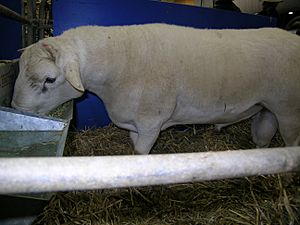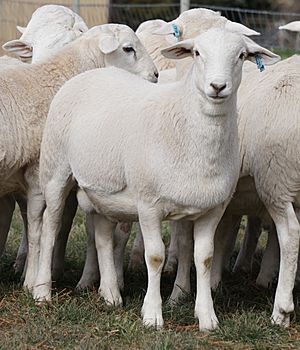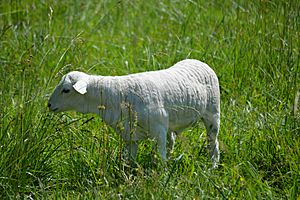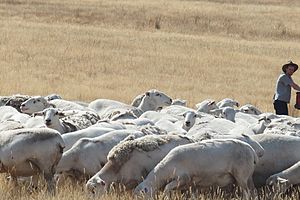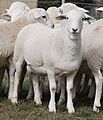Australian White sheep facts for kids
| Country of origin | Australia |
|---|---|
| Use | Meat |
| Traits | |
| Wool color | White |
|
|
The Australian White is a special kind of sheep from Australia. It's a large, white breed raised especially for its meat. What makes it unique is that it doesn't grow wool, so it doesn't need to be sheared!
This breed was created by mixing four other sheep breeds: the White Dorper, Van Rooy, Poll Dorset, and Texel. This mix helped create a strong, healthy sheep perfect for Australian farms.
Contents
Why Was This Sheep Developed?
Farmers wanted a meat sheep that was easier and cheaper to raise. The main goals for creating the Australian White were:
- It wouldn't need shearing or special trimming around its tail (called crutching).
- It would be strong against pests like lice and flies.
- Female sheep (ewes) could have babies all year round.
- It would produce tasty meat with a good shape.
The idea was to make raising lamb more affordable and efficient. This sheep was designed to produce meat without the extra work that comes with wool.
Amazing Meat Quality
The Australian White is famous for its excellent meat. It's known for being very soft, fine-textured, and having a clean taste. It's also special because it's high in healthy fats called omegas. This is one of the biggest differences between its meat and meat from other sheep breeds.
How the Australian White Was Created
The Australian White (AW) breed was developed by two brothers, Graham and Martin Gilmore. They worked on their farms, called Tattykeel properties, in Black Springs, NSW, Australia. After many years of work, they officially launched the breed in 2011.
Smart Breeding Methods
The Gilmore brothers used advanced breeding methods. These included embryo transfer (moving embryos from one sheep to another) and artificial insemination (helping sheep get pregnant without natural mating). They also used careful line breeding to pick the best traits from the four parent breeds.
Their goal was to create a sheep that could:
- Replace itself (meaning it could breed its own replacements).
- Shed its own hair, so no shearing was needed.
- Survive in very different weather, from cold and wet to hot and dry.
- Grow up quickly.
- Breed all year long.
The special meat quality of the Australian White was noticed early on. Later, in 2016, a scientist named Associate Professor Aduli E.O. Malau-Aduli discovered the scientific reasons behind its amazing taste. Today, you can find Australian White sheep in many countries, including New Zealand, China, and the United States.
What Makes Them Special?
Physical Features
Australian White sheep have distinct looks.
- Rams (male sheep) are big and strong. They have a long, straight back and a deep body. They usually weigh between 240 to 265 pounds (110 to 120 kg). Their heads look more masculine and are a bit darker.
- Ewes (female sheep) are also long and deep-bodied. They usually weigh between 150 to 175 pounds (68 to 80 kg). Their heads look more feminine.
These sheep grow a thick coat of hair in winter to stay warm. In warmer months, they shed this coat, and their hair becomes finer. They are chosen for their thick, soft skin. The thickness of their winter coat changes depending on how cold the weather is where they live.
Growing and Producing Meat
Australian White sheep grow up fast! They are ready to breed and produce meat around 10-12 months old. Sheep that mature early are more efficient for farmers. They need less food and time to grow lambs for meat.
These lambs can reach weights of 105-115 pounds (48-52 kg) by 16-18 weeks of age. They are designed to grow well just by eating grass. This means farmers usually don't need to feed them expensive grains.
Because they grow quickly and don't need much special care, Australian Whites help farmers make more profit. They also have a calm nature, which makes them easier to handle.
Meat Quality Secrets
The meat quality is what truly sets the Australian White apart. Scientists have studied the fat in their meat, especially the intramuscular fat (IMF) and fat melting point (FMP).
The fat in Australian White lamb melts at a much lower temperature (82-95°F or 28-35°C) than typical lamb (110°F or 43°C). This is similar to expensive Wagyu beef, which also has fat that melts easily. This low melting point means the meat is very tender and flavorful.
These fat traits also show that the meat has high levels of healthy omega-3 fatty acids. Omega-3s are good for your heart and overall health. Australian White lamb has much more omega-3s than other lamb breeds and popular red meats.
In 2019, a special meat brand called Margra was created for the United States. This brand uses only Australian White lamb. The name "Margra" comes from Martin and Graham Gilmore, the brothers who developed the breed. Margra lamb is known for its high quality and consistent taste.
Ongoing Research
Scientists are still studying the meat quality of Australian White sheep. Associate Professor Aduli E.O. Malau-Aduli, PhD, continues to work with Tattykeel. They take small samples of meat from live animals to test them without harming the sheep.
This research helps farmers find the best sheep lines for meat quality. It also shows that the excellent eating quality of these sheep can be passed down to their babies.
Scientists are also working to find a special DNA signature for Australian White sheep. This will help prove that their meat is genetically different and has more healthy omega-3s. This research could even help lamb meat be seen as a healthy food choice, not just a tasty one!
Images for kids


